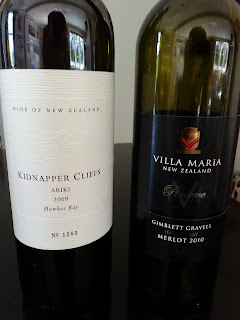It didn’t take long for us to appreciate the quality of the
Bordeaux-styled wines from the Gimblett Gravels in Hawke’s Bay. The wines generally achieve ripeness to a
delicious level, and in comparison to other districts in The Bay, they do so
with more consistency. And I’m sure
there’s a unique flavour profile which I describe as ‘iron-earth’. It is a minerally expression. On top of it all, the soils must imbue
structure, which lends seriousness to the wines. SWMBO and I purchased two wines from the Gimblett
Gravels as they showed all of the impressive characteristics of the
district. From the very warm and dry
2009 and just slightly cooler 2010 vintage, these wines are now approaching
their plateau, so there’s another two-thirds of the way to go for them.
The 2009 Kidnapper
Cliffs ‘Ariki’ Hawke’s Bay is a Merlot-dominant wine. It has always had a touch of tobacco
complexity. And now, this is its
feature, lending a savouriness that is individual. Also, the extraction is not out of kilter. Made by Pinot Noir techniques, due to the Dry
River connection, the maceration was minimal.
The wines still were black as black, and they did not lack
extraction. Now, down the track, there’s
a little garnet, and the textures ultra-smooth, but still with enough structure
to hold all the flavours in place.
Integrated acidity, even in 2009, kept it all alive and with a future to
go. In comparison, the 2010 Villa Maria ‘Reserve’ Gimblett Gravels
Hawke’s Bay Merlot was more youthful.
Black-red in colour, the fruit was more in the black plum spectrum, with
liquorice unfolding. This had vitality
and life, with brilliantly balanced acidity.
And the structure more pronounced, but extremely fine-grained and
powdery. Sheer class on release, still sheer class now. Two glorious wines developing nicely.








